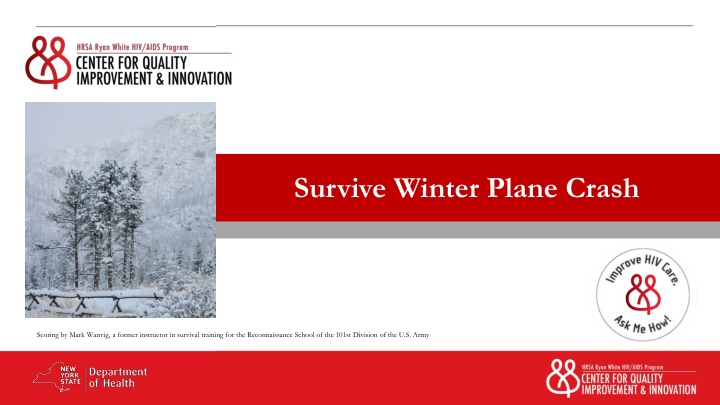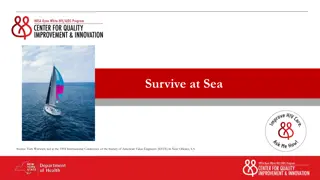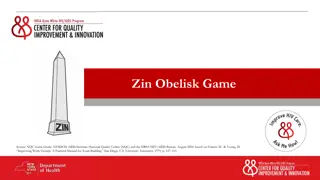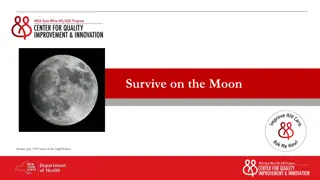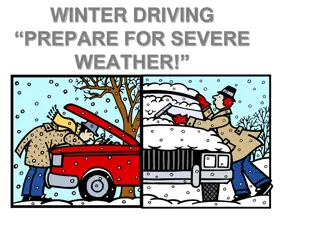Survive Winter Plane Crash - Team Problem Solving Game Overview
Engage in the 'Survive Winter Plane Crash' team problem-solving game to learn about collaboration, prioritization, and group dynamics. Navigate a scenario of survival in Northern Canada after a plane crash, where you must rank and prioritize items for your survival. Suitable for staff, quality improvement teams, and anyone interested in teamwork exercises. For detailed instructions and facilitator guide, visit www.CQII.org.
Download Presentation

Please find below an Image/Link to download the presentation.
The content on the website is provided AS IS for your information and personal use only. It may not be sold, licensed, or shared on other websites without obtaining consent from the author.If you encounter any issues during the download, it is possible that the publisher has removed the file from their server.
You are allowed to download the files provided on this website for personal or commercial use, subject to the condition that they are used lawfully. All files are the property of their respective owners.
The content on the website is provided AS IS for your information and personal use only. It may not be sold, licensed, or shared on other websites without obtaining consent from the author.
E N D
Presentation Transcript
Survive Winter Plane Crash Scoring by Mark Wanvig, a former instructor in survival training for the Reconnaissance School of the 101st Division of the U.S. Army
Overview Game: Survive Winter Plane Crash Length: 20-30 minutes Type of Game: A team problem solving game that emphasizes prioritization and collaboration. Target Audience: Staff, quality improvement team members, people with HIV, and anyone else who are part of an improvement team. Learning Objectives Learn about how groups outperform individuals when solving complex challenges. Engage participants in a creative way to demonstrate the importance of team problem solving Demonstrate the importance of collaboration. Learn how to prioritize and find consensus among team members of a group. Agenda 1. Setting the stage for the interactive exercise. 2. Playing the Survive Winter Plane Crash game. 3. Debrief and discussion on what lessons learned are and how they apply to HIV care. For more information | Check out the CQII Virtual Game Guide (2021) at www.CQII.org, including additional games, resources and the corresponding facilitator guide 4. Feedback and close. 2
Overview: Survive Winter Plane Crash Introduction to Game Scenario Individual Ranking Group Discussion and Ranking Debriefing 3
Game Scenario You and your companions have just survived the crash of a small plane. Both the pilot and co-pilot were killed in the crash. It is mid-January , and you are in Northern Canada. The daily temperature is 25 below zero and the nighttime temperature is 40 below zero. There is snow on the ground, and the countryside is wooded with several creeks crisscrossing the area. The nearest town is 20 miles away. You are all dressed in city clothes appropriate for a business meeting. Your group of survivors managed to salvage 12 items. 4
Items Recovered A ball of steel wool Extra shirt and pants for each survivor A small ax A loaded .45-caliber pistol Can of Crisco shortening Newspapers (one per person) Cigarette lighter (without fluid) 20 x 20 ft. piece of heavy-duty canvas A sectional air map made of plastic One quart of 100-proof whiskey A compass Family-size chocolate bars (one per person) 5
Individual Ranking: 3 minutes What are the most important items? Using the Reporting Form, place the number 1 by the most important item, the number 2 by the second most important, and so on through number 12 for the least important. 6
Group Ranking: 20 minutes Form Groups: 8-10 individuals and assign one facilitator, one observer and a recorder. Discuss the ranking of the recovered items in the group and develop one ranking. Using the Reporting Form, place the number 1 by the most important item, the number 2 by the second most important, and so on through number 12 for the least important. 7
Scoring For each item, mark the number of points that your score differs from the ranking suggested by Mark Wanvig, then add up all the points. Disregard plus or minus differences. The lower the total, the better your score. Example: Individual Ranking 5 and Mark Wanvig Ranking 10; count 5 points. Score the individual and group rankings. Scoring by Mark Wanvig, a former instructor in survival training for the Reconnaissance School of the 101st Division of the U.S. Army 8
Experts Rankings Item Rank Item Rank 3 5 12 10 11 Extra shirt and pants for each survivor 2 6 9 4 8 1 A ball of steel wool 20 x 20 ft. piece of heavy-duty canvas A small ax A sectional air map made of plastic A loaded .45-caliber pistol One quart of 100-proof whiskey Can of Crisco shortening A compass Family-size chocolate bars (one per person) Newspapers (one per person) 7 Cigarette lighter (without fluid) 9
Answers to Winter Plane Crash 1. Cigarette lighter (without fluid) - The gravest danger facing the group is exposure to cold. The greatest need is for a source of warmth and the second greatest need is for signaling devices. This makes building a fire the first order of business. 2. Ball of steel wool - To make a fire, the survivors need a means of catching he sparks made by the cigarette lighter. This is the best substance for catching a spark and supporting a flame, even if the steel wool is a little wet. 3. Extra shirt and pants for each survivor - Besides adding warmth to the body, clothes can also be used for shelter, signaling, bedding, bandages, string (when unraveled), and fuel for the fire. 4. Can of Crisco shortening - This has many uses. A mirror-like signaling device can be made from the lid. After shining the lid with steel wool, it will reflect sunlight and generate 5 to 7 million candlepower. This is bright enough to be seen beyond the horizon. It can also be rubbed on exposed skin for protection against the cold. When melted into an oil, the shortening is helpful as fuel. When soaked into a piece of cloth, melted shortening will act like a candle. The empty can is useful in melting snow for drinking water. It is much safer to drink warmed water than to eat snow, since warm water will help retain body heat. Water is important because dehydration will affect decision-making. The can is also useful as a cup. 10
Answers to Winter Plane Crash 5. 20 x 20 foot piece of canvas - The cold makes shelter necessary, and canvas would protect against wind and snow (canvas is used in making tents). Spread on a frame made of trees, it could be used as a tent or a wind screen. It might also be used as a ground cover to keep the survivors dry. It s shape, when contrasted with the surrounding terrain, makes it a signaling device. 6. Small ax - Survivors need a constant supply of wood in order to maintain the fire. The ax could be used for this as well as for clearing a sheltered campsite, cutting tree branches for ground insulation, and constructing a frame for the canvas tent. 7. Family size chocolate bars (one per person) - Chocolate will provide some food energy. Since it contains mostly carbohydrates, it supplies the energy without making digestive demands on the body. 8. Newspapers (one per person) - These are useful in starting a fire. They can also be used as insulation under clothing when rolled up and placed around a person s arms and legs. A newspaper can also be used as a verbal signaling device when rolled up in a megaphone-shape. It could also provide reading material for recreation. 11
Answers to Winter Plane Crash 9. Loaded .45-caliber pistol - The pistol provides a sound-signaling device. (The international distress signal is 3 shots fired in rapid succession). There have been numerous cases of survivors going undetected because they were too weak to make a loud enough noise to attract attention. The butt of the pistol could be used as a hammer, and the powder from the shells will assist in fire building. By placing a small bit of cloth in a cartridge emptied of its bullet, one can start a fire by firing the gun at dry wood on the ground. The pistol also has some serious disadvantages. Anger, frustration, impatience, irritability, and lapses of rationality may increase as the group awaits rescue. The availability of a lethal weapon is a danger to the group under these conditions. Although a pistol could be used in hunting, it would take an expert marksman to kill an animal with it. Then the animal would have to be transported to the crash site, which could prove difficult to impossible depending on its size. 10. Quart of 100 proof whiskey - The only uses of whiskey are as an aid in fire building and as a fuel for a torch (made by soaking a piece of clothing in the whiskey and attaching it to a tree branch). The empty bottle could be used for storing water. The danger of whiskey is that someone might drink it, thinking it would bring warmth. Alcohol takes on the temperature it is exposed to, and a drink of minus 30 degrees fahrenheit whiskey would freeze a person s esophagus and stomach. Alcohol also dilates the blood vessels in the skin, resulting in chilled blood belong carried back to the heart, resulting in a rapid loss of body heat. Thus, a drunk person is more likely to get hypothermia than a sober person is. 12
Answers to Winter Plane Crash 11. Compass - Because a compass might encourage someone to try to walk to the nearest town, it is a dangerous item. It s only redeeming feature is that it could be used as a reflector of sunlight (due to its glass top). 12. Sectional air map made of plastic - This is also among the least desirable of the items because it will encourage individuals to try to walk to the nearest town. It s only useful feature is as a ground cover to keep someone dry. 13
Scoring 14
Debriefing Did you do better individually or as a team? What were the reasons that the individuals or the teams performed better? How did your team reach its decisions? Was everyone s input considered? How well did the group function as a team? What could be improved? How does this game apply to HIV care and/or your HIV program? 15
Reflections What are the lessons learned from this game? How can a group reach a common goal? Teamwork can produce better results than individual work, especially when faced with complex issues. Healthy team dynamics are critical to team work and development; the role of the group leaders/facilitators is important. It is important to take the time to obtain all team members views and perspectives. A benefit of teamwork is often the diversity in culture, opinion and experience. 16
Center for Quality Improvement & Innovation 212-417-4730 (phone) 212-417-4684 (fax) www.CQII.org Info@CQII.org This project is supported by the Health Resources and Services Administration (HRSA) of the U.S. Department of Health and Human Services (HHS) as part of an award totaling $1.5M. The contents are those of the author(s) and do not necessarily represent the official views of, nor an endorsement, by HRSA, HHS or the U.S. Government. 17
